Verdict
Sonos’ Roam is the portable speaker we thought the Move could be. As a cheaper, smaller alternative to the bigger speaker, it boasts excellent sound quality, an impressive list of features, and a build quality that will help it survive outdoors.
Pros
- Excellent, neutral-sounding performance
- Well built
- New features are useful
- Easy to use
- Auto Trueplay
Cons
- Sonos S2 can be a little flaky with new features
- Could be said it lacks visual pizzazz
- Wireless charging plate an optional extra
Key Specifications
- Review Price: £159
- IP67 rating
- Tweeter and custom racetrack mid-woofer drivers
- Auto Trueplay
- Sound Swap
- Bluetooth 5.0
- Supports Alexa/Google Assistant
The Sonos Roam is arguably the portable speaker we were expecting when news emerged of Sonos’ first Bluetooth-capable effort back in 2019.
And that’s no slight on the Sonos Move, but its size and weight (3kg!) didn’t scream portability – and, at £399, it wasn’t yelling affordability either.
So like that video of Homer Simpson walking back into a bush, Sonos has walked back the ‘portability’ of the Move and framed it as an outdoor speaker for all those gatherings in the gardens and parks that will become de rigueur in 2021. The Sonos Roam, as implied by the name, is a portable speaker in the truest sense.
Sonos Roam price and availability
The Sonos Roam goes on sale on 20 April, 2021 for £159 / $169 / €179. It will also be available to purchase in a number of other countries worldwide on the same date including Canada and Australia.
The Roam Wireless Charger is available for pre-order, and in the UK it will cost £44.
Sonos Roam design – Goes wherever you go
- Sturdy build quality
- Respectable looks
- Lightweight design
The Sonos Roam is the Toblerone-shaped speaker we’ve all secretly desired, but haven’t publicly admitted to wanting. According to Sonos, you could fit six Roams inside one Move, which speaks to the Roam’s differing modus operandi.
It adheres to the modern design approach Sonos has applied to its recent speakers, with its sealed design and a mesh pattern to indicate the ‘front’ of the speaker. If you look at it from the right angle (or light), you can see the honeycomb pattern that covers the tweeter and custom racetrack mid-woofer inside.
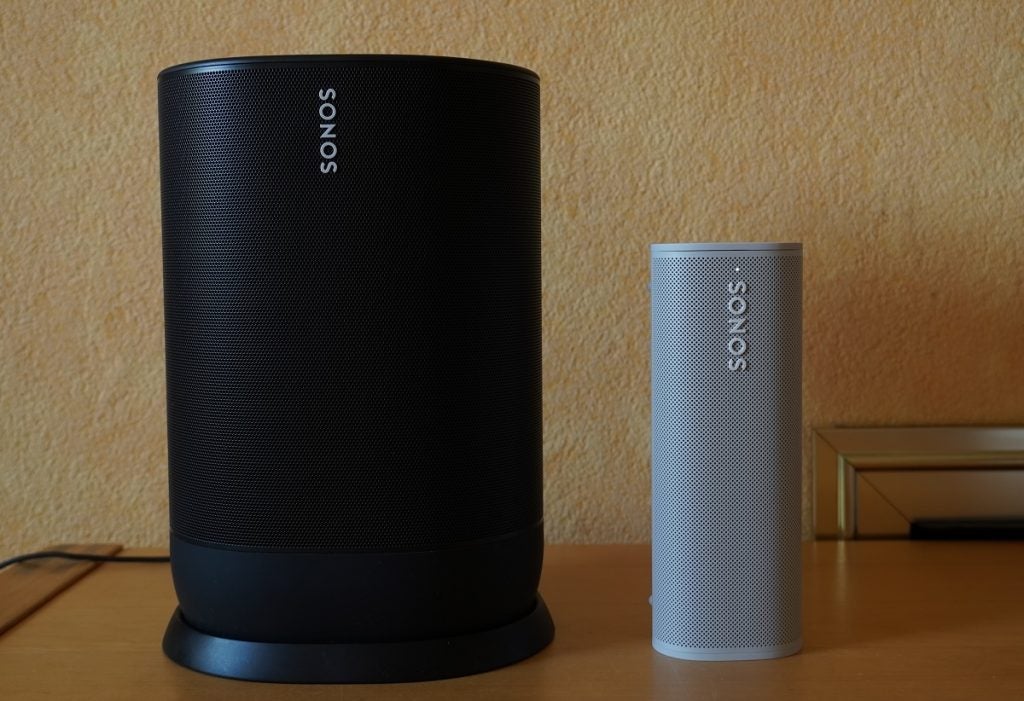
Physical tactile controls sit on top (or side, depending on the orientation) for playback, volume control and the microphone on/off. There are little nubbins (or feet) on the ‘bottom’, while around the back you’ll find a multi-function button powering the speaker on/off, or flipping it between Bluetooth and Wi-Fi modes.
In short, this speaker is pretty easy to operate, although the amount of time you need to hold down the button to swap between modes can confuse – or, perhaps, I’m easily confused. I’ve been told holding down the button for ten seconds switches it off, but a short press appears to achieve the same outcome.
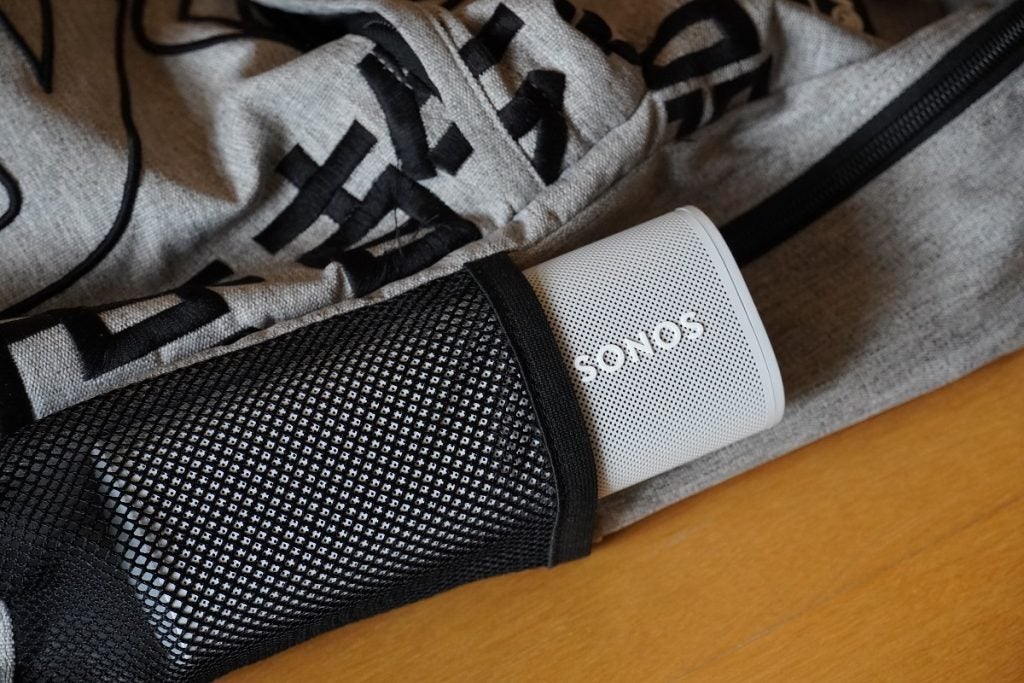
The Roam is well built – there’s nothing toy-like about its feel or appearance. I’d call it anonymously sleek and refined, but typically Sonos. At 430g, it’s lightweight but feels solid in the hand. If you’re looking for an injection of fun, of the type you’d find in the Wonderboom series, the Roam won’t deliver. Available in a choice of Shadow Black and Lunar White – the same as the Move – this portable speaker is for grown-ups.
That it can be used vertically and horizontally adds flexibility in terms of placement. Upright to fit on a bookshelf or horizontal on a wider, flatter surface, the Roam looks classy, no matter the position in which you decide to place it. Potentially, the only real knock is the lack of a hook, which would have made it even more versatile for hanging off backpacks and the like.
Sonos Roam features – High quality feature list blows most portable speakers out of the water
- Sound Swap and instant Bluetooth/Wi-Fi switching
- Sonos S2 app can be unstable with Sound Swap
- Wide music streaming support
- Auto Trueplay for optimising audio
The sell line of the Roam is the same as the Move. Connected to your Wi-Fi, it behaves like any other Sonos speaker in the home (well, almost); take it outdoors, and it becomes like any other Bluetooth speaker.
Connected via Wi-Fi brings Alexa and Google Assistant integration (you can’t access them in Bluetooth mode), along with access to however many music services you can listen to through the Sonos S2 app and Apple AirPlay 2 (which brings Siri to the party). Like the Move you can’t use the Roam as rear speaker in a home cinema set-up.
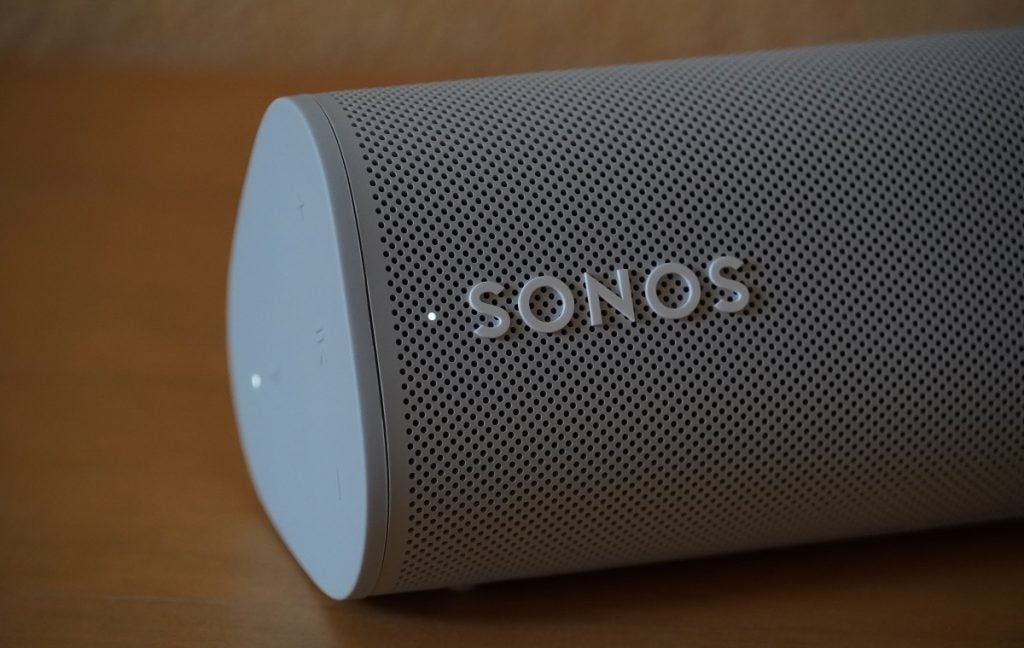
Setting up voice support – if you’re interested in a digital butler – is a breeze, although Sonos has said there will be an update that improves battery life when Google Assistant is enabled. Guidance now is that it’s best to power down the speaker once you’re done using Google Assistant. There’s no timeframe for the update – and if that’s a bother, then Goggle Assistant can be easily removed from the speaker via the settings.
Battery life is up to 10 hours – again, the same as the Move. The reason for this is that although the Move stores more energy in its battery, it produces a bigger audio output and goes louder than the Roam. In doing so, it dissipates that energy over the same length of time.

There’s a USB-C connection around the back, but I think you’ll want to keep the USB-C cable that comes with the Roam safe for the time being. I’ve used two other cables to see if they’d charge the Roam from a mains plug and a laptop and both have had little effect. Sonos recommends a 10W USB power adapter to be sure. The Roam does support Qi wireless charging, but the plate is available separately.
Sonos’ Auto Trueplay is back, optimising the audio for whichever environment the Roam finds itself in. Its appearance removes the need to manually calibrate for each environment – which, quite frankly, is a godsend. The effect isn’t always noticeable, but I’d wager that’s a sign of how well it works. If you listen carefully then you can hear a slight change in pitch, but the result – so far – is a consistent performance no matter you are.

The introduction of the Roam has brought a few new interesting features. One is the Sound Swap feature, whereby holding the play/pause button sends music to the nearest Sonos speaker. And it works, too, sending music speedily to my closest Sonos speaker.
The other feature is automatic reconnection with a smartphone once the Roam has left the comfort of the Sonos mesh network. Having travelled to a family member’s house and powered up the Roam, it needed no invitation to pair up with a smartphone. Returning home and it’s back on the Wi-Fi. Simple as.
However, it hasn’t been a completely fuss-free experience. Perhaps it’s my Wi-Fi – the number of times it’s popped up leads me to think not – but there were occasions where music wouldn’t play from Spotify Connect/Tidal, the connection would be briefly lost, or they’d be lag in the S2 app.
Another odd issue with the Sound Swap speaker was that the units would appear grouped as if playing music at the same time, before music cuts out completely. It’s the first instance of instability using the S2 app I’ve had in a while – and if it’s something more than just my Wi-Fi, hopefully Sonos will sort out the gremlins.
Sonos Roam audio quality – One of the best-sounding portable speakers
- Clear and detailed sound
- Impressive vocals
- Versatile sound
Not surprisingly, considering it’s a Sonos product, the Roam sounds really good. That’s not to say Sonos’ entry into the (true) portable speaker market beats the competition hands-down, but few can match the refinement of the Roam.
It has a similar character to the other two Sonos speakers I have (Move and One SL). Obviously, it isn’t as big-sounding or as bassy as the Move, while the One SL sounds ‘fuller’ in its presentation. Nevertheless, the Roam’s performance is distinctly Sonos in tone.

What’s most impressive is its mid-range clarity and natural sense of performance. The Roam affords voices with great clarity and detail as evidenced by Anette Askvik’s Liberty. You can hear every note, and all without a hint of sibilance making for an expressive vocal performance.
Bass is the aspect of the Roam’s performance that’s weakest. Low frequencies have a defined presence that’s distinct enough from the mid-range. However, in a comparison, the Ultimate Ears Boom 2 has more presence – although you’d be hard-pressed to quantify much of difference. In terms of bass depth, the Roam can’t match the Bang & Olufsen’s Beosound A1 2nd Gen – still the best bass performance I’ve heard from a portable speaker in recent times.
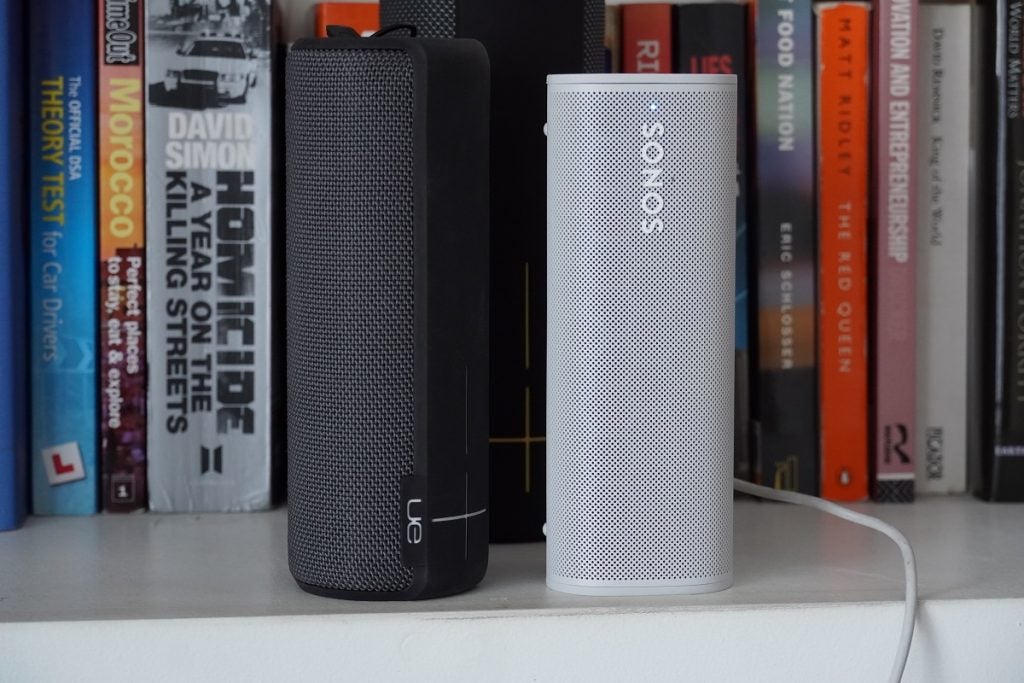
The Roam does beat the Boom 2 for clarity, the UE speaker featuring a slight haziness compared to the Roam’s breezy naturalness. If we’re nit-picking then the soundstage the Roam presents is a compact one, and that can add to the sense of clutter with some busier tracks. However, this is mitigated by the ‘size’ of its sound, which easily fits a medium-sized room and makes plenty of din outside.
Treble is sharply conveyed, adding a pleasing sense of bite and detail at the top of the frequency range, which contributes to the Roam’s impressive sense of tonal balance. Nothing is overly described and little is particularly undercooked – music is delivered in a very measured and confident way that’s evident from the moment the music starts until it stops. Its sense of precision, of fidelity, that leaves the competition – B&O notwithstanding – trailing. It could arguably be more exciting but I enjoy the refinement it offers.
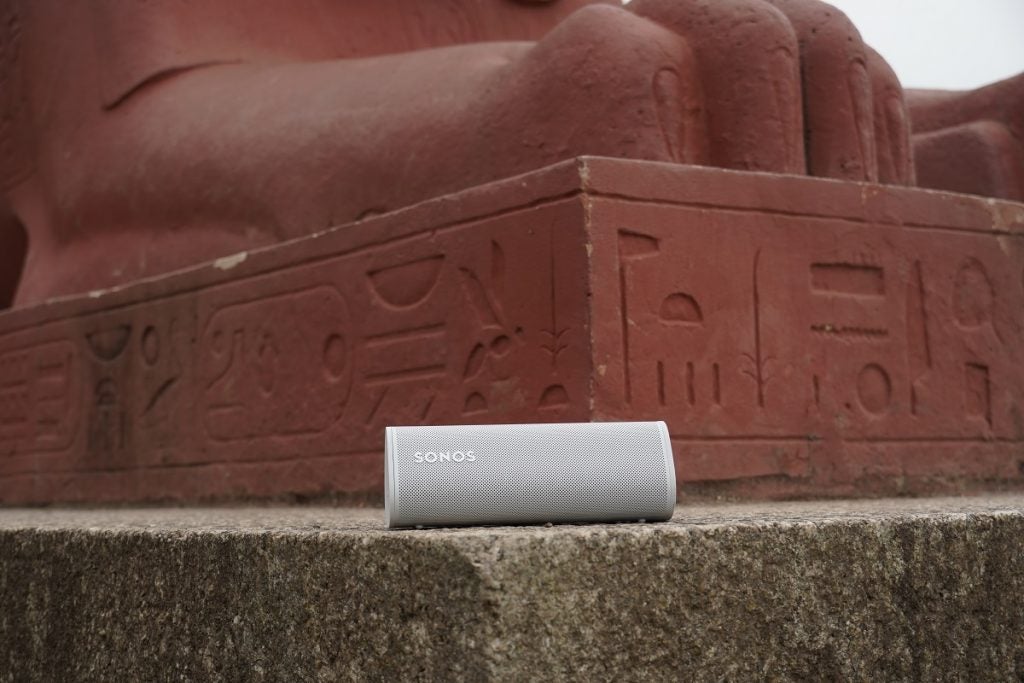
Dynamically, the Roam is terrific with at times expressive sense of highs and lows, while Tom Morello’s cover of Voodoo Child sees the the Roam issue plenty of drive and power to unpack that song’s energy. There’s room to play with the volume levels, too, more so than with Ultimate Ears’ Wonderboom 2. Where the latter can almost tax out just above half-way before it becomes a little unrefined, the Roam can go loud and louder without losing much clarity or detail.
I’ve lost count of the number of different tracks I’ve played through the Roam. Motown, rap, hip hop, electronic, acoustic, rock, indie, instrumentals; the Roam hasn’t faltered with anything I’ve fired at it.
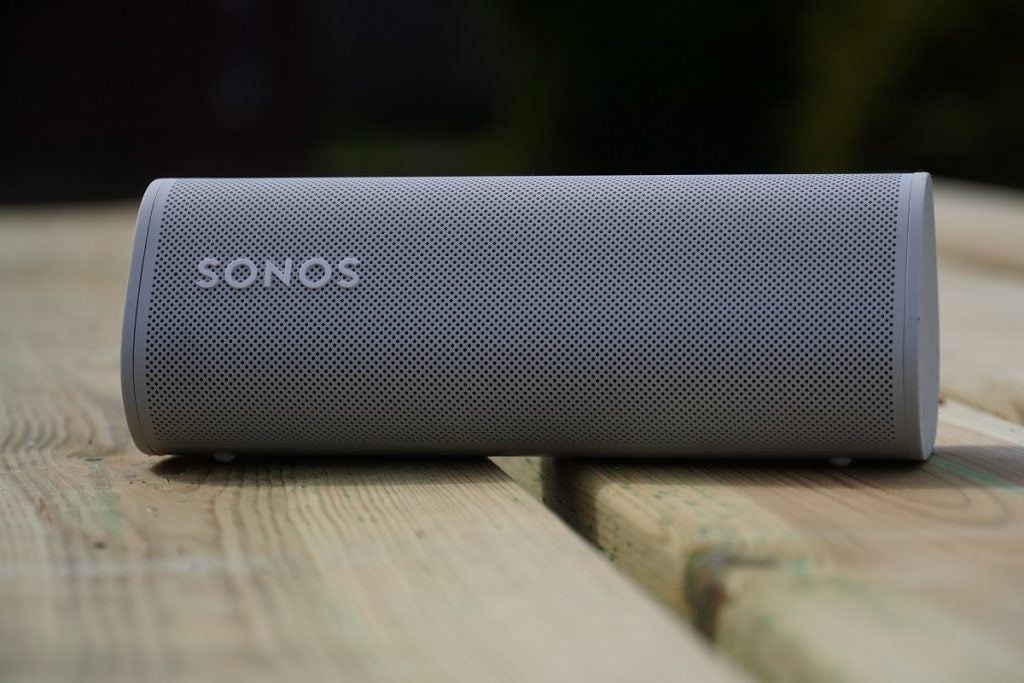
Sonos Roam conclusion
The Roam hits the mark where the Move slightly stumbled in taking Sonos’ sound into the portable arena. It’s sensibly priced given the horde of features it offers; it sounds terrific with all manner of tracks; it’s easy to use, and the build quality is tough enough to survive outdoors. For existing Sonos owners it makes plenty of sense. For everyone else it’s a satisfying intro into the world of Sonos.
You should buy the Sonos Roam if…
- You’re after one of the best-sounding portable speakers on the market
As an introduction to the world of Sonos, the Roam has nailed it on pretty much every level. There’s no compromise in terms of the standard feature set we expect from Sonos, the build quality excels, it’s easy to use and it sounds great. What’s not to like?
You should not buy the Sonos Roam if…
- You’re after a speaker that’s more fun in vibe
There’s a reason that people like the colour and tone of Ultimate Ears’ speakers. It gives them personality. While the Roam isn’t a charisma vacuum, it is – perhaps – straight-edged and respectable in terms of looks. If you’re looking for excitement then perhaps the Roam isn’t for you.